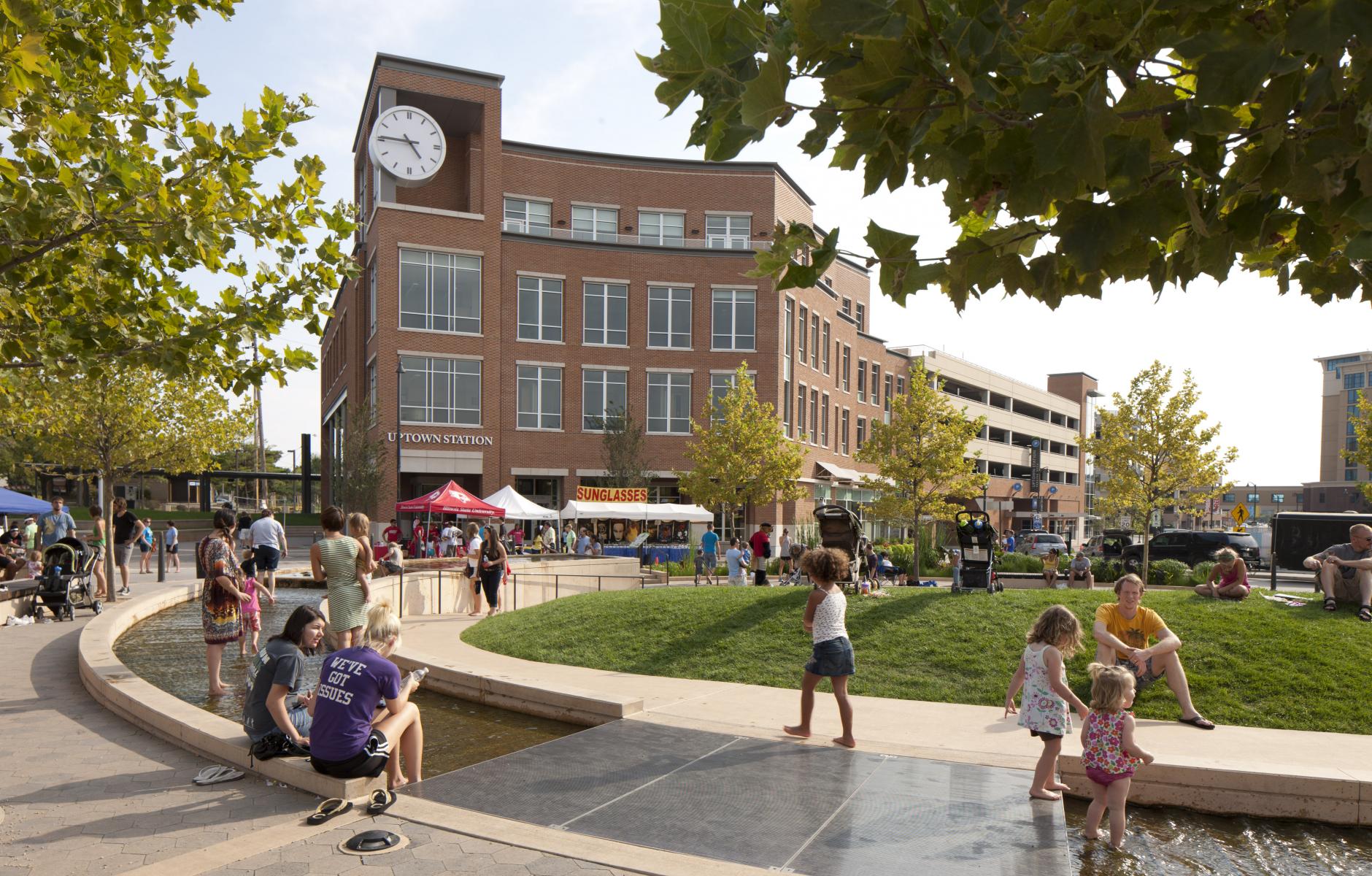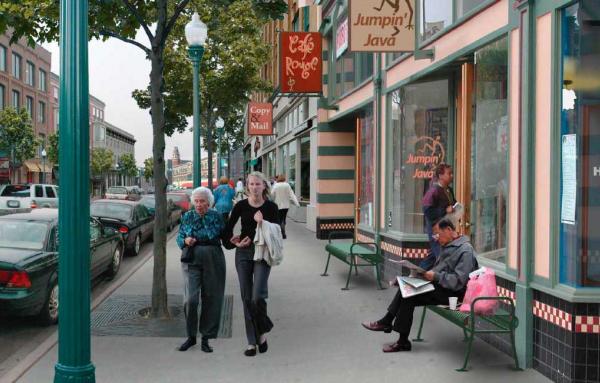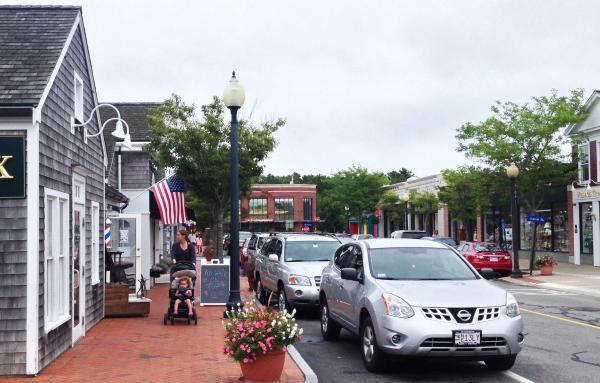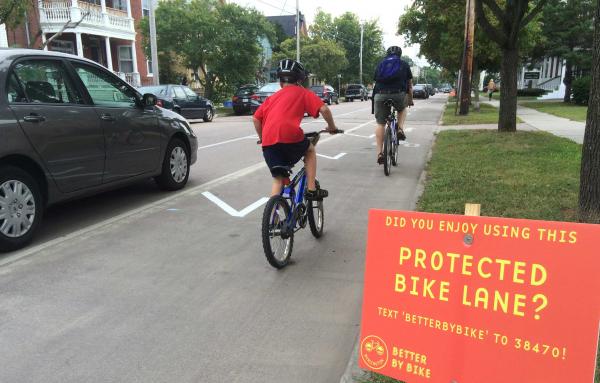
Great idea: Sustainable urbanism
In celebration of the upcoming CNU 25.Seattle, Public Square is running the series 25 Great Ideas of the New Urbanism. These ideas have been shaped by new urbanists and continue to influence cities, towns, and suburbs. The series is meant to inspire and challenge those working toward complete communities in the next quarter century.
Sustainability has been woven into the fabric of New Urbanism since the beginning. The Charter of the New Urbanism's first paragraph connects "environmental deterioration," and "loss of agricultural lands and wilderness," with "the spread of placeless sprawl, increasing separation by race and income," and "the erosion of society’s built heritage." Unlike mainstream environmentalism, which focused more on natural areas, wilderness, and industrial pollution, the New Urbanism defined environmental protection in terms of an "interrelated community-building challenge."
Public Square editor Robert Steuteville interviews Doug Farr, architect and urban designer with Farr Associates in Chicago and author of Sustainable Urbanism: Urban Design With Nature and the upcoming book Sustainable Nation, and Jessica Millman, a urban planner with Agora Group in Skaneateles, New York, who provides environmental services and is an expert in smart growth and green building standards, on the topic of sustainability and the New Urbanism.

Sustainability and environmentalism have been important threads woven through the New Urbanism from the beginning. But many new urbanists are not primarily environmentalists. How deep and important is the sustainability aspect to the New Urbanism?
Farr: New urbanists are humanists first, and environmentalists second, maybe they're on par. But, we're a humanist movement that values people, and we value all the good things about people: diversity, attending to equity, all those kinds of things. And it would be hard to be a humanist and not also be an environmentalist, because we rely on this planet to get stuff done. So, you're right, it's been there from day one. It's in the Charter. It's in the Transect. Many of the founders and early new urbanists, and I'll name the ones that I point to as basically green building people that shifted over: Peter Calthorpe, Doug Kelbaugh, Ed Marzia. So, there's been a lot of crossover but we also weave a lot of threads together because there's folks that are just traditional town planning folks. There's architecture folk, urban designers and so on that don't have a strongly imprinted sustainability DNA professionally. So, while we are a big tent, all are welcome. And so for me, sustainable urbanism was always this sort of grand unification which was, how can we paint a little picture so that new urbanists understand that their contribution and green building folk and all the others, the Natural Resource Defense Council (NRDC), and all of our friends, that as they're working towards their core work they're also recognizing and supporting the work of others.
Millman: Until the new urbanists recognize the importance of location, on par with design within a particular location, I think you're going to struggle from the deep sustainability standpoint. And this was something that came up over and over again, as Doug knows, through our work, but I think it's still out there and, again, not to trivialize everything that has been done, but until there is a full embracing of the importance of location and the recognition that some locations that are targeted for new urbanist development are, in fact, sprawling locations, I think that the movement's acceptance or adoption of sustainability as a fundamental principle is in question.
Farr: That's provocative. We agree on that and there is a kind of counterpoint, which I'm really obsessed with right now which is—there's no group other than the CNU that really owns codes, and knows how to write a good code, and what's a bad code, and what's a walkable code. So I'm going to push back on Jessica to say this, which is yes, the preferred environmental locations are transit served, and higher density, and walkable, compact, and complex, and urban, all those kinds of things, totally true. And, then, there's the rest of the country that's still grinding out new cul-de-sac subdivisions in 2017 and they don't go away. Ellen Dunham-Jones estimates that maybe a half, maybe 1 percent of all sprawl has been retrofitted. Trivial numbers. Once you subdivide land badly, and the blocks are too big, and everything's a cul-de-sac, there's no calling it back. So, whose job is that? Who's on that?
Wasn't Manhattan a greenfield development at some point? – Philadelphia, Seattle, San Francisco, all greenfield developments at one point? So, how can you determine there should never be a place that grows into a settlement at another location, and say this is a wrong location?
Millman: We are so much smarter about how we grow and develop these days, and we have so much more knowledge about the effects of locational decision making, and given the climate that we are in, and the fact that we are facing down a very real climate change, how can we not take all of that information that we know today and apply it in a smarter more intelligent way in terms of our new locations? I just think that until we have a handle on really retrofitting all of that sprawl, why should we encourage the development of new spaces in far-flung places? I think Doug's response is extremely important and very smart. But I think that, again, from an environmentalist standpoint, location is really important.
How can we resolve this? Because as Doug alluded to, some people will say, "there is this other development that's going on. If I make it better so it could be retrofitted with transit some day, isn't that good and a worth goal as well?" How do you resolve the inherent conflict between location and form?
Millman: I have no problem with work being done along that spectrum. None whatsoever. I am not judging the work of someone that's doing a great, well-designed place somewhere else. But I'm not going to herald it. I'm not going to celebrate it. I'm going to suggest that it's better than the norm, but I'm not going to use it as a model for how we should be growing and developing in the future. My model is more aspirational perhaps, but also based on having location ingrained as a part of the calculus on where to grow and develop.
So what is your model? What projects would you tout?
Millman: My ultimate projects are, or my ultimate place is urban fill development on a brownfield site. To me, that's pretty much the best because you're taking a site that's already fouled up and it's already in an urban location. Hopefully proximate to infrastructure, maybe even has some infrastructure in place already. That to me is pretty important.
Farr: The CNU is what we all recognize to be a community of practice. We're bringing our stuff and we're debating it and fighting about it and that's what makes us a community of pride. The members of the group have to care about their standing. That is to say they want to be recognized as members in good standing of this movement. To me, LEED-ND (LEED for Neighborhood Development, which was created for the US Green Building Council with help of CNU and NRDC) was yet another marker of doing well and receiving recognition from the community of practice.
Now that LEED-ND was mentioned, which you were both involved in that effort, how successful do you think LEED-ND was, and what is the impact that it's having now and in the future?
Millman: So to be honest, LEED ND has not delivered what I thought it would. I felt that we were building a tool that would really transform the marketplace. That said, I think that its power has actually been found in the comprehensive nature of it. It is the place to go if you are looking for the best in sustainable development in building best practices. There is no other tool out there, at the scale of the neighborhood, that has particularly and concisely defined what neighborhood sustainable development is. It's a tool is to help community development organizations and people out there in the trenches that are struggling to convince their neighbors to bring in these new types of development, or to think about transit-oriented development, or walkability and bringing in paths and trails, and on and on. That is its power. It hasn't had this enormous transformative effect, but it's still powerful. And it's still extremely useful. There is an incredible amount of energy and thought that was put into that document, and it still resonates today.
Farr: I'm not quite sure what I thought would happen, but certainly launching into the recession, the whole thing wasn't the scenario I thought. But here's where I would cite its impact. It changed the conversation on sustainability in other rooms across the country completely. USGBC, BREEAM in the UK, and LEED, all of these rated the world building by building. And then suddenly within two years [of LEED-ND], they all had place-based standards. And so that was a pioneering thing, and it changed the conversation today. I want to be sustainable. I want to make a difference. I want to change things. What's the scale of intervention? And suddenly it was the building and/or the community, ideally both.
Millman: LEED-ND did change the conversation at the U.S. Green Building Council, and that is extraordinarily powerful. The fact that, now, all the rating systems have a locational component to them was huge. They actually have things like alternative transportation and things that were just, sort of, given in our system, and that we fought to even have in LEED-ND, are now pieces of other rating systems. And that should not be undervalued.
So take this into a different direction with this question, but I know that you've done some work on this, Doug. So I thought I'd just touch on it, and that is the question of whether New Urbanism has hit a tipping point, and how do we know that if it has hit a tipping point? And what does this mean for sustainability of the built environment if it has?
Farr: I do think we're at a tipping point in the sense that I don't want to come back to CNU 50 and say, "Yeah, sprawl is still going on all across America. We're still doing artisanal code in very refined places that pay high fees and the world is kind of burning." So I would like to figure out how we can work with our affiliates and our teams to tackle a bigger agenda than we have.
Millman: I would say that I have a hard time answering it because a tipping point to me depends on what the ultimate goal is. If one of the important goals of the CNU and the new urbanist movement is gathering people together to talk and mash in this community of practice, then absolutely we're at a tipping point and I think we've been there for awhile. If in fact the goal was no more conventional, cul-de-sac subdivisions, then no, we've been an abject failure.
Farr: What did you mean by tipping point?
I meant a meaningful change in the way that America produces the built environment, the land development, planning and development practices in America, and whether the Charter of the New Urbanism has had a meaningful and broad impact on those practices to the extent that changes in the built environment would have an impact on sustainability. That to me would be a tipping point.
Farr: We are totally not there. I agree with Jessica.
So how did new urbanist initiatives like zoning code reform relate to sustainability? If this is about the future of the planet, what should the goal be for, say, zoning code reform?
Millman: Just because we haven't reached the tipping point yet doesn't mean that the movement and the work of its practitioners isn't worthy of a celebration and worthy of emulation. That's really important. This a very difficult problem to resolve and it doesn't get solved within a couple of decades, it's going to take longer. So in terms of managing and setting expectations, it was never my expectation that it was just going to be a few more years and everything was going to be fine.
Doug, you mentioned artisanal zoning codes, zoning core reform, or form-based codes. Sustainability issues are larger issues, it's not just an example, you have to have an impact on sustainability, you have to do more than just sort of have a nice example here and there, have artisanal form-based codes. So what should the goal be for zoning code reform for the new urbanism to have an impact on something like sustainable urbanism? A meaningful impact?
Farr: So I'm really clear about how the green building movement aims to reform building codes. I've diagrammed it out. The top third is people doing excellent work, by that I mean buildings that exceed the code. They're more energy efficient than code. In the middle is people that write codes and their ability to write a more aggressive code depends on the people on the top doing more and more buildings that exceed code. And then the bottom is the people that actually adopt the codes. And again, the speed with which they adopt the codes has to do with how aggressive they are and how these three things work together.
It's funny because I feel like the CNU really has changed the world's conversation about urbanism as an inadvertent spin-off of just being passionate about doing cool projects. And that's the power of this sort of community of practice. We've never had an ambition to set a target to say, "Hey, our code's work should be to eradicate future cul-de-sacs." So where do we want to go? What should our target be? I would say eradicate the disconnected places because they have harm. You know, public health harm, community building harm, sustainable harm. All those kinds of things. Every engineer that stamps a cul-de-sac, civil-engineered subdivision plan is on the hook for public health, safety, and welfare.
Let me just ask about climate change because it's so important. How can new urbanists best address this issue of climate change? New urbanism in general tends to reduce the impacts of greenhouse gas emissions. But how can you take on such a big issue in a meaningful way?
Farr: What we have completely dropped the ball on, overlooked, not been interested in or maybe we perceive it outside of our field is the carbon impact of the buildings. Certainly we all try to design walkable places where the foot and the bike are preferred over the car. I think that's one of our rock solid things. I will say that I experienced a kind of reaction against the idea that buildings could or even should have something like a solar panel on them. We have an aesthetic that acknowledges the presence of a chimney on a traditional house or building—which is incidentally the heating system—as being acceptable. But a solar panel or a solar hot water panel which might also be the heating system is not. And so I would love the new urbanist to evolve.
Millman: It's interesting to hear you say that you are disappointed with how there was a response to green by some of your colleagues, but you didn't have that same reaction when I mentioned location.
Farr: A guy reached out to us, and said, "Hey, I want to do a net-zero energy neighborhood." "Cool, that's great. Where is it?" We looked at it. It's like terrible location. We declined. Turned out he owned land somewhere near a transit stop, and we're talking to him about that. So my preference would be that the new urban stance is we design projects in the good locations and then we design codes that insist on connected street grids in the bad locations. I guess it's your personal choice whether you then choose to do commissions in the bad places. But at least the public health, safety, and welfare is upheld by a street grid.
I feel like I have to speak a little bit for the “Original Green” because this is an idea in New Urbanism before that term was invented (by architect Steve Mouzon). If you emulate places that were built prior to air conditioning, prior to people driving in everywhere, prior to vinyl siding, etc. you would reduce these influences that are harmful to the environment. How important is that idea to the New Urbanism and how does that fit in with the sustainable urbanism?
Farr: As you might imagine, the green movement is not a monolith and that there's a lot of opportunists who will slap solar panels on the glass box facing east and declare victory, right? So that happens all the time. I totally agree with what you just said, Rob, and we should do all of those things first and then the solar panels.
Can we ask about mitigation versus adaptation? Some people say that mitigation, reducing our greenhouse gas emissions, hasn't worked all that well so far. Nothing seems to stop humans from spewing carbon. What is your view on those two approaches to climate change and how new urbanists should, or could, take them into account?
Millman: It is not just adaptation. We have to continue on the path of mitigation, as well. My concern with the way we've been thinking about adaptation is that the thought of, we're going to save high-value real estate in Florida, that statement freaks me out because it immediately calls to question our commitment to equity. What is a high-value place? And, maybe, a high value place includes a large population center, not necessarily the highest value properties, and that's fine, but still there's an enormous equity issue that comes along with any sort of technical adaptations that we may uncover or need to deploy in our battle for a dense climate change.
From a sustainability standpoint, what ideas or initiatives of the New Urbanism have had the biggest impact?
Millman: Defining walkability.
Note: CNU intern Benjamin Crowther helped to produce this interview and article.







